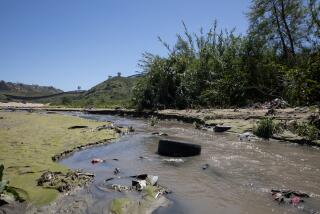Air board will start monitoring pollution next to SoCal freeways
Air quality regulators will begin monitoring pollution levels near major Southern California traffic corridors next year, for the first time providing data important to nearly 1 million Southern Californians who are at greater risk of respiratory illness because they live within 300 feet of a freeway.
Under new U.S. Environmental Protection Agency requirements, air pollution monitors will be installed at four sites next to some of the region’s busiest freeways. Similar steps will occur in more than 100 big cities across the country.
Scientists have linked air pollution from traffic to a long list of health problems, including asthma, heart disease, bronchitis and lung cancer.
Though tens of millions of people nationwide live within a few hundred feet of a major road, monitoring stations established to measure common air pollutants typically have been placed away from such thoroughfares and other obvious sources of contamination. That’s because the monitors are intended to measure pollution across entire regions to determine if they are within health standards set by the state and federal government.
Of the South Coast Air Quality Management District’s 35 air quality monitoring stations measuring pollutants across a four-county basin of 17 million people, none sits close to a major roadway. Environmental groups say that system underestimates exposure levels in many neighborhoods.
The new monitoring is likely to have broad implications. If, as expected, the new data show higher pollution levels, environmental organizations and neighborhood activists almost certainly will call for local officials to take more aggressive steps to reduce emissions and curtail residential development near freeways.
“We will do everything possible to make sure people who live near those roadways get the protections they’re entitled to,” said Angela Johnson Meszaros, an attorney for Physicians for Social Responsibility-Los Angeles, one of several advocacy groups that sued the EPA last year to force it to require fine-particle pollution monitoring near Southern California freeways.
Air quality regulators are now moving in that direction.
“In a place like Los Angeles where a lot of people live next to busy freeways, what you measure near a roadway may actually be representative of what people are exposed to in the basin,” said Philip Fine, who is in charge of the South Coast air district’s network of monitors.
Scott Fruin, a professor of preventive medicine at USC, believes the EPA’s action is long overdue.
“We have known about the adverse health impacts of living near freeways for almost 20 years but don’t routinely monitor air quality there,” said Fruin, whose studies have found that pollution concentrations along Los Angeles freeways that are five to 10 times higher than elsewhere in the city.
Health studies show that the most vulnerable are children, whose developing lungs can be harmed for life by air pollution. In the landmark Children’s Health Study, USC researchers found that children living near busy freeways have higher asthma rates and reduced lung function.
Complicating the picture are new findings by UCLA and the California Air Resources Board that pollutants from cars and trucks can drift more than a mile from Southern California freeways, suggesting that air pollution’s effects could be more widespread than previously thought.
Gledy Martinez, who moved into an apartment a block from the 110 Freeway in downtown Los Angeles four years ago, said in Spanish that at the time, “I didn’t think about how there was a freeway close by.”
The 30-year old cafeteria worker has learned to sleep through the noise from the more than 260,000 vehicles that pass by each day, but she now fears that the exhaust fumes and fine particles that drift over from traffic are unhealthful for her family.
Her 2-year-old son Bryan suffers from bronchitis, and his doctor can’t pinpoint the cause. It could be that their studio apartment is too humid or has too many bugs — or it could be from the pollution from the freeway.
Under EPA rules to be phased in over three years, starting in January, the largest metropolitan areas must put four monitors within about 160 feet of major roadways to measure nitrogen oxides, fine particulates and carbon monoxide. Smaller areas will be required to have between one and three monitors.
The EPA said it has required monitoring near urban roads before, notably for lead and carbon monoxide in the 1970s and ‘80s, when vehicles were fueled with leaded gasoline.
Air monitors in Southern California have tracked pollution at a distance from major roads for decades, documenting the sharp improvement in the region’s smog levels in response to ever-tightening pollution controls. One station in Azusa has been running since 1957, not long after Caltech scientist Arie Jan Haagen-Smit first linked smog to automobile tailpipes. Cars, trucks and buses now account for nearly half the region’s smog-forming pollution.
For the new roadside monitoring sites, the South Coast air district is using a formula taking into account traffic volume, particularly diesel trucks, which pollute more than cars. Some of the top candidates include I-5 near Lincoln Avenue in Anaheim and a two-mile stretch where the 57 and 60 freeways join near the agency’s headquarters in Diamond Bar.
Another potential site is an experimental air monitoring station inside a graffiti-covered shipping container next to the 710 Freeway in Long Beach. The station has been used for scientific studies in recent years, pumping air into a stack of instruments that can track pollution levels 50 feet from the rush of traffic.
Back in her small apartment, Martinez said she welcomes the new monitors.
“You can see there are too many cars, a lot of exhaust, and we don’t breathe clean air,” she said in Spanish. “For me that’s a big worry, more than anything, for my kids, because they are the ones who are still developing.”
More to Read
Sign up for Essential California
The most important California stories and recommendations in your inbox every morning.
You may occasionally receive promotional content from the Los Angeles Times.











